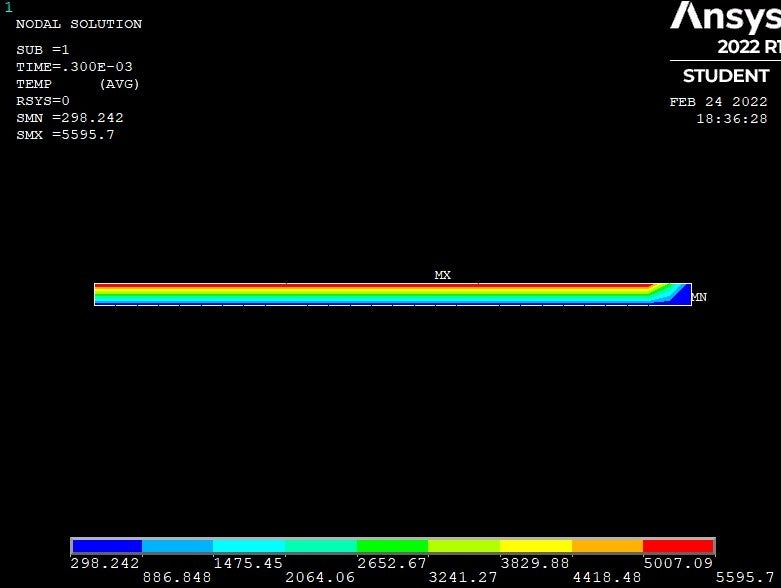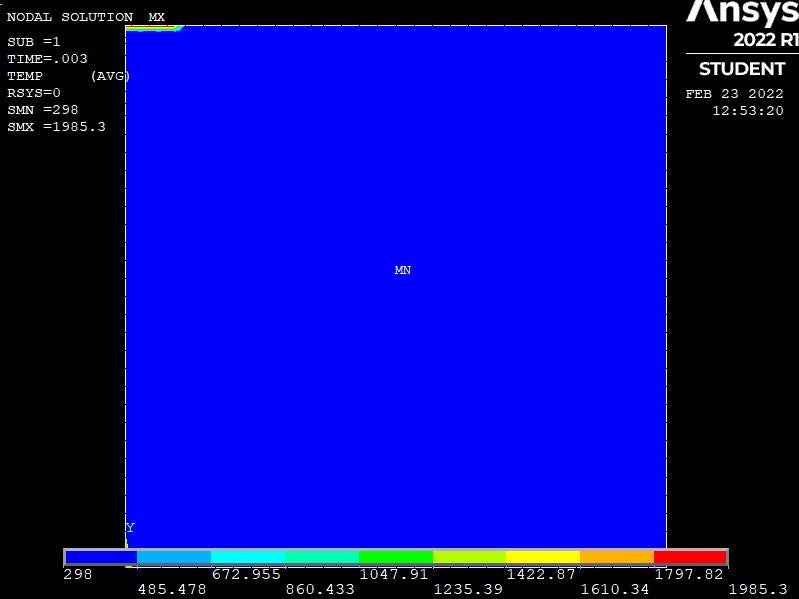TAGGED: transient-thermal
-
-
February 23, 2022 at 7:25 am
Prashanth_Kulkarni
SubscriberHello,
I have been trying to simulate electric discharge machining (transient thermal analysis) on a 2D axisymmetric body using ANSYS APDL software. After obtaining a temperature distribution, I now want to kill the elements above the melting temperature in order to obtain a crater. Can anyone guide me on how to proceed further to get the required results? I'm pretty new to ANSYS so any relevant answer or material would be appreciated
Thank you
February 23, 2022 at 8:36 amSurya Prakash
Ansys Employee
The command NSEL can be used to select the nodes over a particular temperature and the command EKILL can be used to kill those elements. Please refer to this help documentation for the both NSEL - NSEL (ansys.com) and EKILL - EKILL (ansys.com)
Also refer to this example code where a similar application is executed - Performing EKILL Element Death in Workbench Mechanical | SimuTech (simutechgroup.com)
Thanks Surya
How to access the ANSYS Online Help ÔÇö Ansys Learning Forum
Rules & Guidelines ÔÇö Ansys Learning Forum
February 23, 2022 at 8:40 amErKo
Ansys EmployeeHi
Below is a link that shows how to do this using nsel and esln commands:
All the best
Erik
February 23, 2022 at 11:47 amPrashanth_Kulkarni
Subscriberthank you for your swift reply I followed a similar procedure to the one you stated in your answer and was able to select the elements above melting temperature using esln. But, when I try to kill the elements using EKILL,ALL., The following error is showing up. Where did I go wrong? This is the code that I used. I just want to mention that I am doing the whole analysis using ANSYS APDL only and I was giving the code input line by line.
/solu
*do,time_val,0,1,1e-3
!!! Apply load
solve
nsel,s,temp,,1400,1900
esln
ekill,all
 Thank you
Thank you
February 23, 2022 at 1:10 pmErKo
Ansys EmployeeHi
Unfortunately I can not advice and troubleshoot in order to find out why this does not work - perhaps some other users can chime in here.
What we said is that we need a combination of nsel, esln, and ekill commands to do this.
As the message says though the nropt,full needs to be specified before solve and ekill.
All the best
Erik
February 24, 2022 at 2:03 amdinhan0394
SubscriberThe Birth and Death require Full Newton-Raphson solutions. You can active the option by adding the command: NROPT,FULL
NROPT, FULL
/solu
*do,time_val,0,1,1e-3
!!! Apply load
solve
nsel,s,temp,,1400,1900
esln
ekill,all
February 24, 2022 at 1:16 pmPrashanth_Kulkarni
Subscriberand thanks to your guidance and input, I am now able to kill the elements
But, I am facing one problem here. Even though I am using the code
nsel,s,temp,,1400,10000 !to select the elements above 1400 K
esln
to select the elements above the melting point, the elements which are not present in the temperature range are also getting selected. Can you please explain how to tackle this problem?
 As you can see even though I gave a range of 1400 K to 10000K, the elements below 1400K are also getting selected
As you can see even though I gave a range of 1400 K to 10000K, the elements below 1400K are also getting selected
Viewing 6 reply threads- The topic ‘How to select elements which are above a certain temperature and kill them?’ is closed to new replies.
Innovation SpaceTrending discussionsTop Contributors-
4723
-
1565
-
1386
-
1242
-
1021
Top Rated Tags© 2026 Copyright ANSYS, Inc. All rights reserved.
Ansys does not support the usage of unauthorized Ansys software. Please visit www.ansys.com to obtain an official distribution.
-
The Ansys Learning Forum is a public forum. You are prohibited from providing (i) information that is confidential to You, your employer, or any third party, (ii) Personal Data or individually identifiable health information, (iii) any information that is U.S. Government Classified, Controlled Unclassified Information, International Traffic in Arms Regulators (ITAR) or Export Administration Regulators (EAR) controlled or otherwise have been determined by the United States Government or by a foreign government to require protection against unauthorized disclosure for reasons of national security, or (iv) topics or information restricted by the People's Republic of China data protection and privacy laws.












